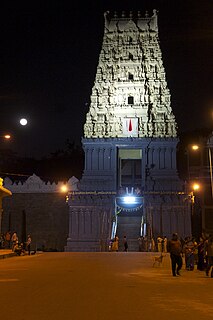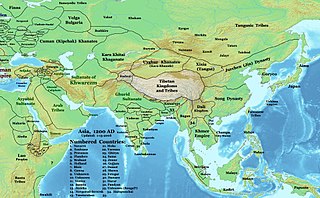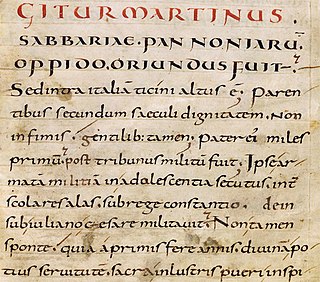
Dvaita Vedanta is a sub-school in the Vedanta tradition of Hindu philosophy. Alternatively known as Bhedavāda, Tattvavāda and Bimbapratibimbavāda, Dvaita Vedanta sub-school was founded by the 13th-century scholar Madhvacharya. The Dvaita Vedanta school believes that God and the individual souls (jīvātman) exist as independent realities, and these are distinct. The Dvaita school contrasts with the other two major sub-schools of Vedanta, the Advaita Vedanta of Adi Shankara which posits nondualism – that ultimate reality (Brahman) and human soul are identical and all reality is interconnected oneness, and Vishishtadvaita of Ramanuja which posits qualified nondualism – that ultimate reality (Brahman) and human soul are different but with the potential to be identical.

The Shri Varaha Lakshmi Narasimha temple, Simhachalam is a Hindu temple situated on the Simhachalam hill, which is 500 metres above the sea level in Visakhapatnam, Andhra Pradesh. It is dedicated to one of the Hindu trinity deities Vishnu, who is worshipped there as Varaha Narasimha. As per the temple's legend, Vishnu manifested in this peculiar form, with a boar head, human torso and a lion's tail, after saving his devotee Prahlada from a murder attempt by the latter's father Hiranyakashipu. Except on Akshaya Tritiya, the idol of Varaha Narasimha is covered with sandalwood paste throughout the year, which makes it resemble a Shiva Lingam.

Vyāsatīrtha, also called Vyasaraja or Chandrikacharya, was a Madhva scholar and poet belonging to the Dvaita order of Vedanta. As the patron saint of the Vijayanagara Empire, Vyasatirtha was at the forefront of a golden age in Dvaita which saw new developments in dialectical thought, growth of the Haridasa literature under bards like Purandara Dasa and Kanaka Dasa and an amplified spread of Dvaita across the subcontinent. Three of his polemically themed doxographical works Nyayamruta, Tatparya Chandrika and Tarka Tandava documented and critiqued an encyclopaedic range of sub-philosophies in Advaita, Visistadvaita, Mahayana Buddhism, Mimamsa and Nyaya, revealing internal contradictions and fallacies. His Nyayamruta caused a significant stir in the Advaita community across the country requiring a rebuttal by Madhusudhana Saraswati through his text, Advaitasiddhi.

Sri Vadiraja Tirtha was a Dvaita philosopher, poet and mystic. A polymath of his time, he authored many works, often polemical, on Madhva theology and metaphysics. Additionally, he composed numerous poems and as the pontiff of Sodhe Mutt, renovated the temple complex at Udupi and established the Paryaya system of worship. He is also credited with enriching the Kannada literature of the time by translating Madhva's works to Kannada, giving impetus and contributing to the Haridasa movement. His works are characterised by their poetic flourishes, incisive wit and humour.

Hoysala literature is the large body of literature in the Kannada and Sanskrit languages produced by the Hoysala Empire (1025–1343) in what is now southern India. The empire was established by Nripa Kama II, came into political prominence during the rule of King Vishnuvardhana (1108–1152), and declined gradually after its defeat by the Khalji dynasty invaders in 1311.

Padmanabha Tirtha was a Dvaita scholar and the disciple of Madhvacharya. Ascending the pontifical seat after Madhva, he served as the primary commentator of his works and in doing so, significantly elucidated Madhva's terse and laconic style of writing. His pioneering efforts in expanding upon the Dvaita texts to uncover the underlying metaphysical intricacies was taken forward by the 14th Century philosopher, Jayatirtha. Padmanabha is also credited with disseminating the philosophy of Dvaita outside the Tulunadu.

The Eastern Ganga dynasty was a medieval Indian dynasty that reigned from Kalinga from the 11th century to the early 15th century. The territory ruled by the dynasty consisted of the whole of the modern-day Indian state of Odisha as well as parts of West Bengal, Andhra Pradesh and Chhattisgarh. The early rulers of the dynasty ruled from Dantapura; the capital was later moved to Kalinganagara, and ultimately to Kataka. Today, they are most remembered as the builders of the Konark Sun Temple, a UNESCO World Heritage site at Konark, Odisha.

No See Also Rudra Sampradaya

The Madhva tradition is a denomination within the Vaishnavism tradition of Hinduism, founded by the thirteenth century philosopher Madhvacharya. It is a movement in Hinduism that developed during its classical period around the beginning of the Common Era. Philosophically, Madhva tradition is aligned with Dvaita Vedanta, and regards Madhvacharya as its founder or reformer.

Puthige Matha or Puttige Mutt in some records and literature is a Madhwa Vaishnava monastery. It is one of the Ashta Mathas of Udupi founded by Dvaita philosopher Madhvacharya of Udupi. The first pontiff of Puttige matha was Sri Upendra Tirtha, who was a direct disciple of Sri Madhvacharya, the founder of the Dvaita school of philosophy. The main idols worshipped in the Puttige matha are that of Panduranga (Vittala), which was given to Sri Upendra Tirtha by Sri Madhvacharya. Till date, there have been 29 pontiffs who have headed the matha.
Jagannatha Dasa (1728–1809), a native of Manvi town in the Raichur district, Karnataka state, India, is considered one of the notable Haridasa saint-poets of the Kannada language. Apart from authoring numerous well-known devotional songs that propagate the Vaishnava bhakti ("faith"), Jagannatha Dasa wrote the Harikathamritasara in the native shatpadi metre and Tattva suvali in the native tripadi metre. He was also an accomplished scholar in the Sanskrit language.
Navabrundaavana is located at Anegundi, near Hampi, Karnataka, India. It contains the Brundaavanas of nine Hindu Madhva saints, who belong to the Uttaradi Mutt, Sri Raghavendra mutt, Sri Vyasaraja mutt and the Sri SriPadaraja mutt and Other Various Prominent Madhwa Mutts. It is located on an island in the Tungabhadra River. The nine saints are
- Shree Padmanabha Tirtha, direct disciple of Jagadguru Shri Madhvacharya
- Shree Kavindra Teertharu
- Shree Vageesha Teertharu
- Shree Raghuvarya Teertharu
- Shree Vyaasa Teertharu or Vyasaraajaru
- Shree Sudheendhra Teertharu
- Shree Srinivaasa Teertharu
- Shree Raama Teertharu
- Shree Govinda Vodeyaru
Madhwa Brahmins or Madhwas are subcaste of Hindu Brahmin community in India. They follow the Dvaita philosophy propounded by Madhvacharya. According to Krishnamurti Sharma They are found mostly in the Indian states of Karnataka, Goa, Tamil Nadu, and Andhra Pradesh.
Satyadharma Tirtha (1743-1830), was a Madhva scholar and poet belonging to the Dvaita order of Vedanta. He was the 28th pontiff of Uttaradi Matha since Madhvacharya from 1797-1830.














